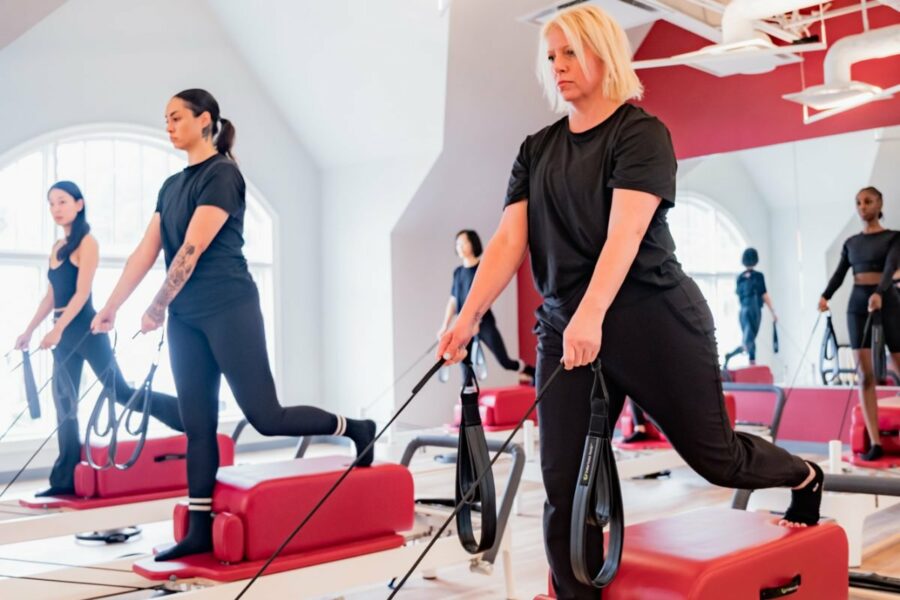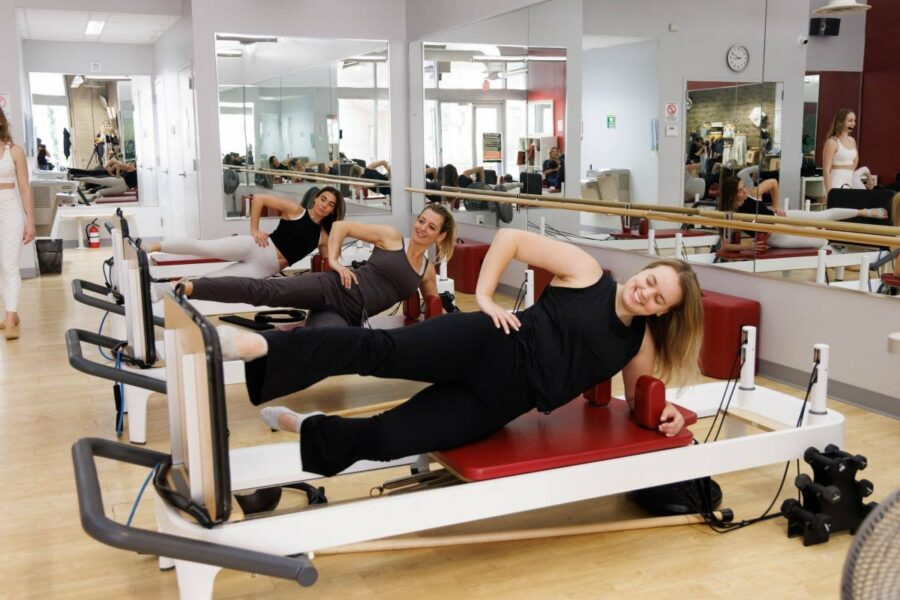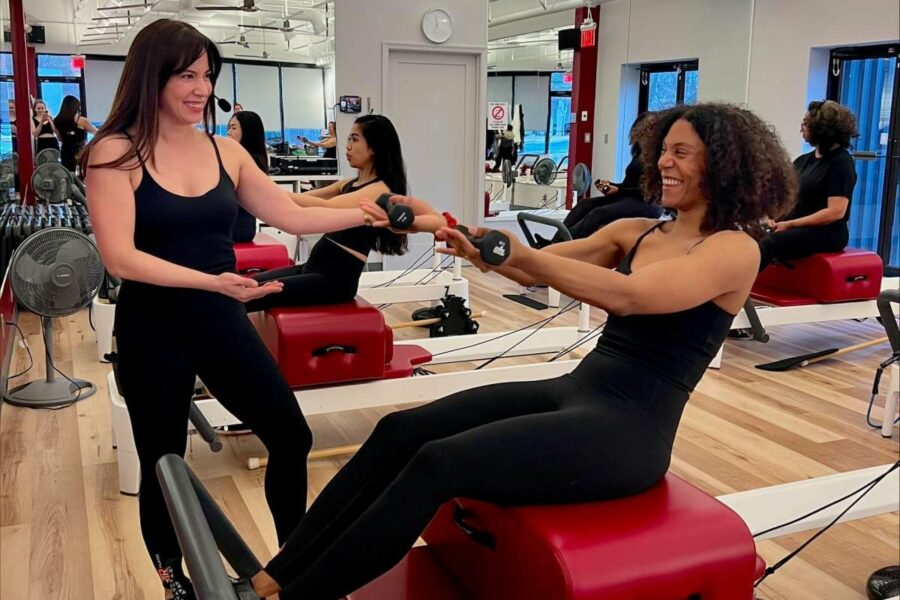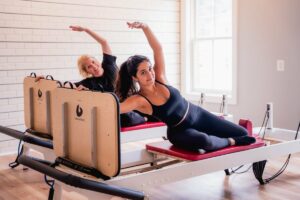 As a beginner in Pilates, many tools, exercises, and concepts are probably still new to you. That’s all right! Pilates for beginners is an accessible and effective workout for beginners, and you’ll learn quickly.
As a beginner in Pilates, many tools, exercises, and concepts are probably still new to you. That’s all right! Pilates for beginners is an accessible and effective workout for beginners, and you’ll learn quickly.
But once you get the hang of how things work, it’s important to start setting goals so you can see how you are improving. Doing so allows you to stay motivated, adjust exercises as needed, and understand how your body changes over time.
Pilates effectively combines physical and mental improvements. If you’re unsure how to track these improvements, here are some suggestions.
Why Setting Pilates Goals Is Important for Beginners
Going into Pilates without a goal in mind can lead to unfocused workouts. You might not get the most out of your hard work if you don’t have goals. Some of the things that goals offer include:
Direction and Focus
When you have at least one goal for your Pilates experience, you can personalize your work toward achieving it. Setting clear goals helps beginners focus on specific areas, such as flexibility, strength, or posture.
Motivation
Another advantage of establishing goals is that they keep you motivated. If you have measurable goals, you can always see how much closer you are to achieving them, giving you that little boost needed to keep going and attend classes regularly.
Sense of Accomplishment
Did you know that you can provide dopamine (the happy, rewarding hormone) to the brain by setting a goal and then achieving it? Even small milestones in your Pilates routine will boost your confidence and encourage long-term participation, which is excellent for your health.
How to Set Realistic Pilates Goals
Are you ready to set some goals for your Pilates workouts? Make sure your goals are realistic to make the most of the experience. Set manageable and specific goals, such as improving core strength or increasing flexibility. Write out the details of precisely what you hope to accomplish, such as being able to touch your toes. The SMART strategy can help!
SMART Goals Framework
 Specific: Focus on a particular area, such as “improving balance.”
Specific: Focus on a particular area, such as “improving balance.”- Measurable: Choose measurable indicators, such as holding a plank for a specific duration or touching your toes.
- Achievable: Set challenging but attainable goals, especially as a beginner.
- Relevant: Align goals with personal fitness objectives, such as posture improvement or reducing back pain.
- Time-Bound: Set a timeframe for achieving the goal (e.g., within three months of starting Pilates).
Examples of Common Beginner Pilates Goals
Not sure where to start with your Pilates goals? Everyone is different, so consider what is relevant to you. You might think about:
- Improving Core Strength: A goal to strengthen the core and support better posture and back health.
- Increasing Flexibility: A goal to improve range of motion, particularly in the hamstrings, hips, and shoulders.
- Enhancing Balance and Coordination: A goal to stabilize movements and improve balance in daily activities.
- Building Consistency: A goal to commit to attending Pilates classes 2-3 times per week to create a routine.
Tracking Improvement in Pilates
Once you set your goals, you need some way to see whether you are achieving them! There are many options for tracking your progress; choose one that suits your personality.
- Progress Journals: Keep a fitness journal to log progress, jotting down what exercises feel easier or more challenging over time. Think about what you couldn’t do before Pilates. Can you do it now?
- Tracking Flexibility: Consider measuring how far you can reach during stretches. Can you touch your toes now? When you twist, can you go deeper than before?
- Strength Markers: Not all measurements of Pilates success can be measured by how far you move your body. Think about other accomplishment metrics, such as increased plank hold duration or completing more advanced Reformer exercises that were intimidating before.
- Balance and Coordination Tests: One fun way to see your progress is to do balance and coordination tests occasionally. Basic tasks such as standing on one leg or holding balance-based exercises can demonstrate how much you’ve improved.
- Feedback from Instructors: You don’t always need to track progress alone! Ask your instructors for feedback on progress and areas for improvement.
- Adjusting Goals as You Progress: Your instructors are a treasure trove of knowledge waiting to be tapped. They can help beginners adjust their goals as they improve, adding new challenges or focusing on different areas.
Celebrating Milestones and Staying Motivated
Tracking your Pilates progress can be motivating by itself, but rewarding yourself for progress is also a great motivator to keep going!
- Acknowledge Small Wins: Even small achievements are worth celebrating! Minor tasks such as mastering a new exercise or regularly attending class deserve recognition.
- Reward Yourself: Consider setting personal rewards for reaching milestones, such as treating yourself to new workout gear or a relaxing activity.
- Join a Community: One of the most engaging ways to stay motivated is to join a Pilates community. You’ll also find support in your growth while being inspired by others’ progress.
Overcoming Plateaus
As you track your success in Pilates, you might find that wins come less and less frequently until you hit a plateau—when you seemingly stop making progress. Although Plateaus are normal, you can overcome them! Try:
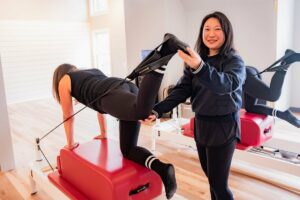 Switching Up Routines: Introducing new exercises or increasing class frequency can help overcome progress plateaus. This allows your body to break out of its rut with the need to adapt to new demands.
Switching Up Routines: Introducing new exercises or increasing class frequency can help overcome progress plateaus. This allows your body to break out of its rut with the need to adapt to new demands.- Patience and Persistence: Keep in mind—fitness progress is not always linear. Staying consistent is essential for long-term improvement. Do not compare your progress to others; this task is your own, and you are doing your body good each time you exercise, regardless of whether you see immediate improvement.
Embrace Pilates as a Beginner
Starting Pilates can feel like a big task, but it is also extremely rewarding! Setting achievable goals and tracking progress as a beginner in Pilates is important so you can see how you are growing and becoming more competent over time.
If you don’t have any goals right now, this is a great time to take that first step and identify what you want to aim for. Sign up now for a trial class at RTR Pilates to start working toward your fitness goals.

